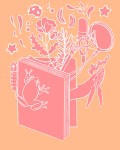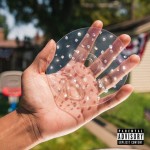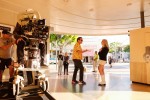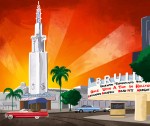In 1981, two UCLA students wondered why Los Angeles didn’t have its own LGBTQ film festival like those in San Francisco and New York – so they set out to create their own.
Since then, the festival has grown into Outfest, Los Angeles’ preeminent LGBTQ film festival, and one of the oldest across the country.
The festival, which takes place July 18 through 28, features several short films created by UCLA alumni, including “First Position,” “Origin” and “Framing Agnes.” The films are all set in various time periods and focus on rewriting society’s narratives about the LGBTQ community.
“First Position”
Michael Elias Thomas grew up filming the moving body in conjunction with music and watching his sister dance.
His film “First Position” was a manifestation of his thesis research in the UCLA School of Theater, Film and Television’s cinematography MFA program, which explored the ways in which body movement can shape and manipulate camera movement. He blended that technical research with a desire to tell a story about the LGBTQ community.
[RELATED: San Diego Comic-Con unites fans, studios, pop culture in single bound]
The film takes place in 1980s San Francisco and follows Zachary, an aspiring dancer whose dreams are put on hold with the onset of HIV/AIDS symptoms. Thomas, the director and cinematographer, shot on film and was inspired by 1980 archival photos, which created a damaged and textured visual aesthetic, but also limited his budget.
“When you’re doing handheld (film), you have the camera right to your ear and you’re just hearing the money just go through the machine,” Thomas said. “I had to know what I wanted when we were shooting, whether it be a certain emotion or a certain movement of the actors.”
Thomas said he wanted to highlight dance in telling his story since he respects how dance is able to reveal meaning through movement. By intercutting dance sequences with scenes such as a character having a breakdown or a romantic scene, Thomas used the choreography to underscore the emotions of the scenes.
“My main goal was to, instead of using dialogue to push the story forward, … use dance and dance movements, different choreography to establish what was happening,” Thomas said. “It’s all through how the bodies interact with each other.”
“Origin”
Simone Lyles set out to explore sexuality in an introspective way, imagining the ways in which an internal discovery could be realized visually on screen.
“Origin,” written, directed and edited by Lyles, plays with the boundary between imagination and reality. Set in 1980s Oakland, the film centers on Cora, a woman in love with her best friend who turns to self-help conversion therapy tapes to try to come to terms with her sexuality.
Lyles sought to convey Cora’s thoughts and subconscious desires visually on screen, but she said the importance of creating personal fantasy extended beyond narrative function. For Lyles, making a queer film about people of color was important for validating underrepresented experiences.
“What’s important for me in the fantasy-reality (relationship) is letting queer people of color a space to be able to fantasize,” Lyles said. “The idea that we can be multi-dimensional people and have thoughts that do manifest visually in our heads, what does that look like as an artist trying to depict that nuance?”
In addition to depicting new fantasy on screen, Lyles said “Origin” debunks fiction, pushing back on a narrative often placed on queer communities – that someone chooses to be gay. The film takes its name from Cora’s conversion tapes, which urge her to revisit her past and find the point when she first chose to be gay.
“I decided to call it ‘Origin’ in a contradiction of the actual process,” Lyles said. “There is no origin, there’s no such thing, but the (tape) was trying to get her to go through that process of finding this moment that truly didn’t exist.”
“Framing Agnes”
Agnes’ story originates at UCLA in multiple ways – it’s where co-directors Chase Joynt and Kristen Schilt met, and it‘s also the starting point for a 1958 case study that defined sociological research on transgender identity.
In 1958, a patient named Agnes approached Ronald Reagan UCLA Medical Center for sex reassignment surgery and was interviewed by psychiatrist Dr. Robert Stoller and sociologist Harold Garfinkel. Stoller and Garfinkel’s studies were published in the 1960s, and Agnes was considered to be one of the first case studies of an individual who may today identify as transgender.
[RELATED: From panels to cosplay to art, thousands of fans find community at Anime Expo]
While working on the Mellon Foundation Fellowship together, Joynt and Schilt were granted access to Garfinkel’s private archive and found additional unpublished case studies Garfinkel had performed with gender non-conforming individuals. Finding the studies inspired “Framing Agnes,” an experimental documentary featuring prominent trans actors, including Angelica Ross of “Pose” and Zackary Drucker of “Transparent,” playing the people from the case studies.
The actors’ jobs extended beyond reading transcripts from the studies and understanding the details of the person’s life story. In addition, they focused on understanding each subject as a full and complete person, finding a connection between themselves and the character they were inhabiting, Joynt said.
“(Telling the story) required opening up the creative space to allow our actors to inhabit these historical subjects in ways that felt resonant for them,” Joynt said. “So yes, they are inspired and pulling from real lives and real transcripts but also, there is this very necessary creative slippage where our actors inhabit the fantasy hauntings of people who they feel very connected to.”
Joynt and Schilt said they focused on the sociological impact of both Agnes’ case and the exclusion of the other cases from publication. Agnes’ story was isolated and used to set medical standards for gender non-conforming people, obscuring the true diversity of the LGBTQ community while also harming individuals who differed from Agnes, Schilt said.
“In the transcripts, many of the people say to the doctors, ‘I’m really glad I’m telling you my story because I think this is going to be useful, many generations are going to be able to benefit from the knowledge I’m giving you,’” Schilt said. “The fact that they don’t really get written about is sad, and I think being able to feature that in the movie was a shift for us that was important.”






